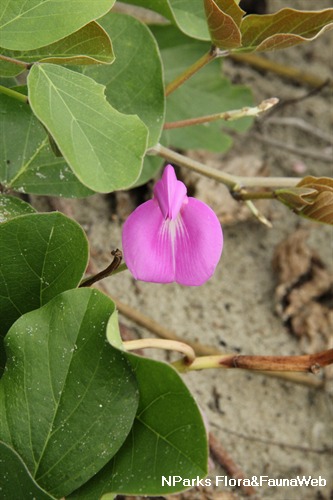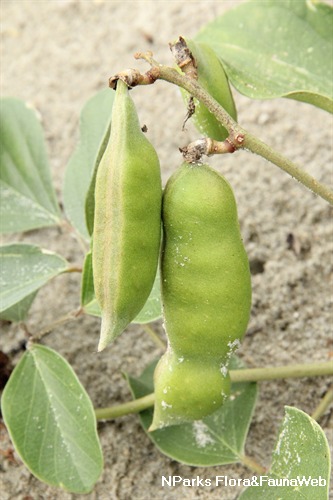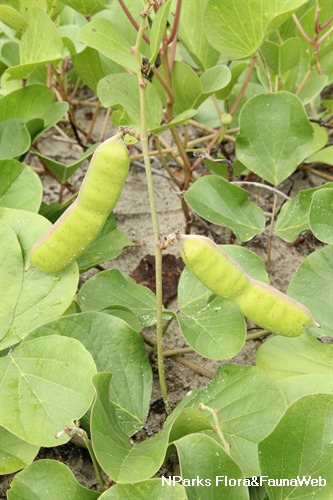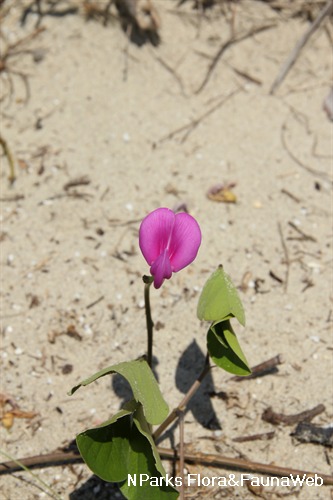
Back
Canavalia rosea (Sw.) DC.
| Family Name: | Fabaceae (Leguminosae) |
| Synonyms: | Canavalia apiculata, Canavalia arenicola, Canavalia baueriana, Canavalia emarginata, Canavalia maritima |
| Common Name: | Bay Bean, Beach Bean, Seaside Bean, Coastal Jackbean, MacKenzie Bean, Greater Sea Bean, 海刀豆 |
Name
Classifications and Characteristics
| Plant Division | Angiosperms (Flowering Seed Plants) (Dicotyledon) |
|---|---|
| Plant Growth Form | Climber |
| Lifespan (in Singapore) | Perennial |
| Mode of Nutrition | Autotrophic |
| Plant Shape | Irregular |
Biogeography
| Native Distribution | Tropical coastal areas |
|---|---|
| Native Habitat | Shoreline (Sandy Beach) |
| Preferred Climate Zone | Tropical |
| Local Conservation Status | Native to Singapore (Least Concern (LC)) |
Description and Ethnobotany
| Growth Form | It is a trailing, twining, slightly hairy, non-woody plant. |
|---|---|
| Foliage | Its alternate, stalked leaves are trifoliolate (bearing 3 leaflets). Its stalked leaflets have somewhat fleshy leaf blades that are broad or rounded, 5–14 by 4.5–10 cm, and with shortly-pointed or notched tips. |
| Stems | The thick stem can grow to more than 2.5 cm in diameter. |
| Flowers | Its flowering shoot is about 30 cm long and found at the leaf axils. Its purple flowers are sweetly-scented and notched at the tips. |
| Fruit | Its fruits are dry, dehiscent pods (legumes), linear-oblong, 6–15 by 1.5–3 cm, and contain many dark brown seeds. |
| Habitat | It grows along sandy seashores. It occurs locally in Pasir Laba Camp and Pulau Ubin (Chek Jawa). |
| Associated Fauna | Its flowers are insect-pollinated. |
| Cultivation | This drought and salt tolerant species is ideal for sunny locations with nutrient poor, but well-drained soils. It has a fast growth rate, so it needs to be restrained by pruning. It can be propagated by seed. |
| Etymology | Latin canavalia, after the Malabar vernacular name, kanavali, for these climbing herbs or sub-shrubs; Latin rosea, rose-like, possibly referring to the pink flowers. |
| Ethnobotanical Uses | Edible Plant Parts : Edible Fruits, Edible Flowers, Edible Seeds Food (Fruit or Vegetable): In northern Australia, the seeds and immature pods are used as food. Mature seeds are roasted or boiled before consumption. The flowers are edible. Others: In many countries, this species is used to prevent soil erosion. |
Landscaping Features
| Landscaping | It may be suitable for parks and the skyrise greening in buildings. |
|---|---|
| Desirable Plant Features | Ornamental Flowers, Ornamental Foliage, Fragrant (Flowers) |
| Landscape Uses | General, Parks & Gardens, Small Gardens, Coastal, Beachfront / Shoreline, Suitable for Rooftops, Groundcover |
Fauna, Pollination and Dispersal
| Pollination Method(s) | Biotic (Fauna) |
|---|---|
| Seed or Spore Dispersal | Abiotic |
Plant Care and Propagation
| Light Preference | Full Sun |
|---|---|
| Water Preference | Moderate Water, Little Water |
| Plant Growth Rate | Fast |
| Rootzone Tolerance | Drought Tolerant, Moist Soils, Well-Drained Soils, Saline Soils / Salt Spray, Easy to Grow |
| Maintenance Requirements | Moderate |
| Propagation Method | Seed |
Foliar
| Foliage Retention | Evergreen |
|---|---|
| Mature Foliage Colour(s) | Green |
| Foliar Type | Compound (Trifoliate) |
| Foliar Arrangement Along Stem | Alternate |
| Foliar Attachment to Stem | Petiolate |
| Foliar Shape(s) | Non-Palm Foliage (Orbicular / Round) |
| Foliar Venation | Pinnate / Net |
| Foliar Margin | Entire |
| Foliar Apex - Tip | Retuse |
Floral (Angiosperm)
| Flower & Plant Sexuality | Bisexual Flowers |
| Flower Colour(s) | Pink |
|---|---|
| Flower Grouping | Cluster / Inflorescence |
| Flower Location | Axillary |
| Individual Flower Shape | Papilionaceous / Pea-shaped |
| Inflorescence Type | Spike |
| Flowering Period | Free-Flowering |
Fruit, Seed and Spore
| Mature Fruit Colour(s) | Brown |
|---|---|
| Fruit Classification | Simple Fruit |
| Fruit Type | Dehiscent Dry Fruit , Legume / Pod |
| Mature Seed Colour(s) | Brown |
Image Repository
Others
| Master ID | 30828 |
|---|---|
| Species ID | 5184 |
| Flora Disclaimer | The information in this website has been compiled from reliable sources, such as reference works on medicinal plants. It is not a substitute for medical advice or treatment and NParks does not purport to provide any medical advice. Readers should always consult his/her physician before using or consuming a plant for medicinal purposes. |




_lowres.jpg)
_lowres.jpg)
_lowres.jpg)
.jpg)
_lowres.jpg)